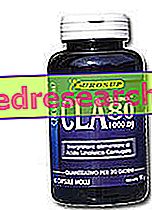
Information on CLA 80 Eurosup
CLA 80 Eurosup
Food supplement based on conjugated linoleic acid
FORMAT
Pack of 60 capsules
COMPOSITION
Conjugated linoleic acid (CLARINOL CLA 80); Jelly; Glycerine; Purified water; Antioxidant: mix of natural tocopherols
Per serving (3 capsules): CLA 2.4 grams
Product Features CLA 80 Eurosup

In nature the synthesis of CLA is achieved through a series of reactions known as incomplete biohydrogenation, induced by microorganisms present in the rumen (stomach with digestive functions present in ruminants); these microorganisms make these animals - and products derived from them, such as milk - the richest food source. In addition to products of animal origin, an alternative source of conjugated linoleic acid is represented by vegetable oils, such as those of sunflower and safflower.
The CLA came to the fore due to the casual discovery of its antimutagenic effect, subsequently characterized and justified on various animal models, with the presence of biologically active isomers. Many experimental models of prostate cancer, breast cancer, and intestine have tested the anticarcinogenic effect of CLA, observing different benefits in the various stages of carcinogenesis, hypothesizing a mechanism to control the cell cycle and the synthesis of arachidonic acid.
The inhibition of the synthesis of arachidonic acid, which would be explained by the competitive action against linoleic acid, its substrate, could be important in the prevention of atherosclerotic problems, reducing the synthesis of factors promoting platelet aggregation such as TXA 2 .
Numerous studies are still testing the possible benefits and potential risks that would result from the therapeutic application of CLA in degenerative, metabolic and nutritional endocrine disorders.
CLA and weight
Despite the potential virtues listed above, CLA is now used primarily as an adjunct in weight loss. In this regard, the scientific literature has not yet expressed a definitive opinion, given the large amount of data, evidently conflicting. While animal testing has produced highly repeatable and consistent results in supporting the slimming effect of CLA, various clinical trials seem somewhat distant to confirm its usefulness in humans .
From the dozens of published works and the thousands of people tested, it is possible to trace a statistically valid profile on the effectiveness of CLA in assisting weight loss; in particular, the average weight reduction by CLA compared to placebo is estimated at 0.09kg per week
Numerous other studies also show the efficacy of this long chain fatty acid in ensuring weight maintenance after a heavy weight loss, even if the data published in this regard do not allow definitive or statistically significant results to be drawn.
Although the amount of work involved is impressive, it has not yet been possible to clarify the mechanism of action of CLA, although some in vitro and in vivo evidence on animal models suggest:
- Increased expression of uncoupling proteins: the increased mitochondrial expression of these proteins allows to dissipate most of the proton gradient in the form of thermal energy, reducing the synthesis of ATP (see brown adipose tissue);
- Increased apoptosis of preadipocytes;
- Increased beta oxidation: induction of carnitine acetyl transferase expression;
- Increased total energy expenditure;
- Increased lipolysis, with consequent reduction in cell volume and lipid drop.
Rationale - CLA 80 Eurosup
To date, it is not yet possible to draw a definitive picture on the real benefits and on the potential damages deriving from supplementation with CLA. In fact, it is important to consider that the results, both positive and negative, obtained on animal models, although well documented and characterized, cannot and must not be extended to humans. Therefore, in re-reading published scientific works, and in evaluating the positive effects sponsored by the various companies, attention must always be paid to the type of study, the type of sample used, the presence of a control group as a term of comparison and the presence of statistically significant data.
Recommended use by the company - CLA 80 Eurosup
We recommend taking 3 soft capsules a day, distributed throughout the day.
Use in sports - CLA 80 Eurosup
In the various studies published in the literature, dosages emerge that - although quite different - are in the range between 2 and 6.4 g / day. However, it seems that the most effective dosage is 3.4 g / day, which is the maximum loss of 0.14 kg / week. However, it should always remain in the range of 0.015 - 0.1 gr / kg per day.
The total dose should be divided into at least 3 daily intakes, possibly during meals, in order to facilitate intestinal absorption.
In this case it would be enough to take 3 to 4 soft capsules a day, equally divided during meals.
Although the various studies show dosages even in the long term, up to 12 months with a linear loss in the first 6, which tends to decrease thereafter, it is always necessary to consult your doctor before starting the intake and if you decide to prolong its use over 4 weeks
Synergies CLA 80 Eurosup
DIETARY PLAN AND PHYSICAL ACTIVITY: in order for CLA to assist weight loss, it is NECESSARY to program a controlled, healthy and possibly low-calorie diet, associated with a programmed physical activity adapted to individual needs.
Also in this case it is possible to describe some studies carried out on animals that associate CLA to arginine, recording positive effects on the increase in lean mass, but which make little sense, given the absence of the equivalent in humans.
Side Effects CLA 80 Eurosup
Despite the absence of serious side effects recorded following the intake of CLA, there are various reports of possible pejorative effects in various pathological conditions:
- Increase in inflammatory biomarkers (reactive c protein and white blood cells): despite these findings, CLA has proved particularly useful due to its anti-inflammatory properties.
- Increase in insulin resistance: this effect, which seems to be more pronounced for the T10, C12 isomer, drops significantly when an evenly composed mixture is used.
- Increased oxidative stress: increased lipoperoxidation levels.
- Dyslipidemic effect: associated with the T10 isomer, C12 materializes with a reduction in plasma HDL cholesterol levels, with an increase in LDL.
Precautions for using CLA 80 Eurosup
The product is contraindicated in cases of renal or hepatic disease, cardiovascular disease and / or hypertension, during pregnancy, during lactation and under 14 years. In the event of prolonged use (over 6/8 weeks), medical advice is required.
This article, elaborated on the critical re-reading of scientific articles, university texts and common practice, is for informational purposes only and is therefore not a medical prescription. It is therefore always necessary to consult your doctor, nutritionist or pharmacist before starting to use any kind of supplement . Further information on the critical analysis of CLA 80 Eurosup.
| BIBLIOGRAPHY |
. November; 44 (11): 975-82. Epub 2009 Sep 25. Conjugated linoleic acid induces uncoupling protein 1 in white adipose tissue of ob / ob mice. Wendel AA, Purushotham A, Liu LF, Belury MA. Nutr Rev. 2008 Jul; 66 (7): 415-21. Plourde M, Jew S, Cunnane SC, Jones PJ. Eur J Clin Nutr. 2003 Oct; 57 (10): 1268-74. Effect of conjugated linoleic acid supplementation after weight loss on appetite and food intake in overweight subjects.Kamphuis MM, Lejeune MP, Saris WH, Westerterp-Plantenga MS. J Food Sci. 2007 Oct; 72 (8): S612-7. Conjugated linoleic acid (CLA) prevents body fat accumulation and weight gain in an animal model.Park Y, Albright KJ, Storkson JM, Liu W, Pariza MW. J Nutr Biochem. 2008 Jan; 19 (1): 61-8. Epub 2007 May 24. Chromium picolinate and conjugated linoleic acid do not synergistically influence diet and exercise-induced changes in body composition and health indexes in overweight women.Diaz ML, Watkins BA, Li Y, Anderson RA, Campbell WW. No synergistic effect Am J Clin Nutr. 2007 May; 85 (5): 1203-11. Whigham LD, Watras AC, Schoeller DA. J Nutr. 2005 Apr; 135 (4): 778-84. Supplementation with conjugated linoleic acid for 24 months is well tolerated by body fat mass in healthy, overweight humans.Gaullier JM, Halse J, Høye K, Kristiansen K, Fagertun H, Vik H, Gudmundsen O. Lipids. 2009 Nov; 44 (11): 983-8. Epub 2009 Oct 23. Conjugated linoleic acid isomers, t10c12 and c9t11, are differentially incorporated into adipose tissue and skeletal muscle in humans.Goedecke JH, Rae DE, Smuts CM, Lambert EV, O'Shea M. J Nutr. 2009 Jul; 139 (7): 1279-85. Epub 2009 May 13. Dietary supplementation of L-arginine and conjugated linoleic acid reduces retroperitoneal fat mass and increases lean body mass in rats.Nall JL, Wu G, Kim KH, Choi CW, Smith SB. Int J Obes (Lond). 2007 Mar; 31 (3): 481-7. Epub 2006 Aug 22. The role of conjugated linoleic acid in reducing body fat and preventing holiday weight gain.Watras AC, Buchholz AC, Close RN, Zhang Z, Schoeller DA. Riserus U, Arner P, Brismar K, Vessby B. Treatment with dietary trans10cis12 conjugated linoleic acid causes isomer-specific insulin resistance in obese men with the metabolic syndrome. Diabetes Care 2002; 25: 1516-2 Int J Obes Relat Metab Disord. 2003 Jul; 27 (7): 840-7. The effect of conjugated linoleic acid supplementation after weight loss on body weight regain, body composition, and resting metabolic rate in overweight subjects.Kamphuis MM, Lejeune MP, Saris WH, Westerterp-Plantenga MS. Eur J Clin Nutr. 2005 Apr; 59 (4): 508-17. Effect of CLA supplementation on an immune function in young healthy volunteers.Song HJ, Grant I, Round D, Mohede I, Sattar N, Heys SD, Wahle KW. |



